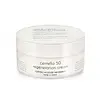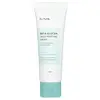What's inside
What's inside
 Key Ingredients
Key Ingredients

 Benefits
Benefits

 Concerns
Concerns

 Ingredients Side-by-side
Ingredients Side-by-side

Centella Asiatica Extract 50%
CleansingCyclopentasiloxane
EmollientGlycerin
HumectantWater
Skin ConditioningCetearyl Alcohol
EmollientButylene Glycol
HumectantCyclohexasiloxane
EmollientDimethicone
EmollientPolysorbate 60
Emulsifying1,2-Hexanediol
Skin ConditioningGlyceryl Stearate
EmollientBeta-Glucan
Skin ConditioningBetaine
HumectantSorbitan Stearate
EmulsifyingPEG-100 Stearate
Caprylyl Glycol
EmollientAllantoin
Skin ConditioningAloe Barbadensis Leaf Extract
EmollientDipotassium Glycyrrhizate
HumectantEthylhexylglycerin
Skin ConditioningSodium Hyaluronate
HumectantAdenosine
Skin ConditioningSodium Chondroitin Sulfate
Skin ConditioningPentylene Glycol
Skin ConditioningAspalathus Linearis Extract
Skin ConditioningGlycyrrhiza Glabra Root Extract
BleachingCamellia Sinensis Leaf Extract
AntimicrobialMelissa Officinalis Leaf Extract
Skin ConditioningAlchemilla Vulgaris Leaf Extract
AntioxidantVaccinium Angustifolium Fruit Extract
Skin ProtectingRosmarinus Officinalis Leaf Extract
AntimicrobialRosa Canina Fruit Extract
AstringentEuterpe Oleracea Fruit Extract
Vaccinium Macrocarpon Fruit Extract
AstringentHibiscus Sabdariffa Flower Extract
Skin ConditioningYucca Schidigera Root Extract
Skin ConditioningCommiphora Abyssinica Resin Extract
Skin ConditioningPerilla Frutescens Leaf Extract
MaskingCentella Asiatica Extract 50%, Cyclopentasiloxane, Glycerin, Water, Cetearyl Alcohol, Butylene Glycol, Cyclohexasiloxane, Dimethicone, Polysorbate 60, 1,2-Hexanediol, Glyceryl Stearate, Beta-Glucan, Betaine, Sorbitan Stearate, PEG-100 Stearate, Caprylyl Glycol, Allantoin, Aloe Barbadensis Leaf Extract, Dipotassium Glycyrrhizate, Ethylhexylglycerin, Sodium Hyaluronate, Adenosine, Sodium Chondroitin Sulfate, Pentylene Glycol, Aspalathus Linearis Extract, Glycyrrhiza Glabra Root Extract, Camellia Sinensis Leaf Extract, Melissa Officinalis Leaf Extract, Alchemilla Vulgaris Leaf Extract, Vaccinium Angustifolium Fruit Extract, Rosmarinus Officinalis Leaf Extract, Rosa Canina Fruit Extract, Euterpe Oleracea Fruit Extract, Vaccinium Macrocarpon Fruit Extract, Hibiscus Sabdariffa Flower Extract, Yucca Schidigera Root Extract, Commiphora Abyssinica Resin Extract, Perilla Frutescens Leaf Extract
Water
Skin ConditioningButylene Glycol
HumectantGlycerin
HumectantMethyl Trimethicone
Skin ConditioningCentella Asiatica Extract
CleansingBeta-Glucan
Skin ConditioningCetearyl Alcohol
Emollient1,2-Hexanediol
Skin ConditioningNiacinamide
SmoothingHydrogenated Polyisobutene
EmollientIsononyl Isononanoate
EmollientCetearyl Glucoside
EmulsifyingGlyceryl Stearate
EmollientSorbitan Stearate
EmulsifyingCetearyl Olivate
Sorbitan Olivate
EmulsifyingAcrylates/C10-30 Alkyl Acrylate Crosspolymer
Emulsion StabilisingBetaine
HumectantAllantoin
Skin ConditioningAdenosine
Skin ConditioningDipotassium Glycyrrhizate
HumectantGlucose
HumectantSodium Hyaluronate
HumectantArginine
MaskingPrunus Salicina Fruit Extract
AntioxidantPunica Granatum Fruit Extract
AntioxidantRubus Idaeus Fruit Extract
AstringentFragaria Vesca Fruit Extract
AstringentPrunus Persica Fruit Extract
AbrasiveWater, Butylene Glycol, Glycerin, Methyl Trimethicone, Centella Asiatica Extract, Beta-Glucan, Cetearyl Alcohol, 1,2-Hexanediol, Niacinamide, Hydrogenated Polyisobutene, Isononyl Isononanoate, Cetearyl Glucoside, Glyceryl Stearate, Sorbitan Stearate, Cetearyl Olivate, Sorbitan Olivate, Acrylates/C10-30 Alkyl Acrylate Crosspolymer, Betaine, Allantoin, Adenosine, Dipotassium Glycyrrhizate, Glucose, Sodium Hyaluronate, Arginine, Prunus Salicina Fruit Extract, Punica Granatum Fruit Extract, Rubus Idaeus Fruit Extract, Fragaria Vesca Fruit Extract, Prunus Persica Fruit Extract
 Reviews
Reviews

Ingredients Explained
These ingredients are found in both products.
Ingredients higher up in an ingredient list are typically present in a larger amount.
1,2-Hexanediol is a synthetic liquid and another multi-functional powerhouse.
It is a:
- Humectant, drawing moisture into the skin
- Emollient, helping to soften skin
- Solvent, dispersing and stabilizing formulas
- Preservative booster, enhancing the antimicrobial activity of other preservatives
Adenosine is in every living organism. It is one of four components in nucleic acids that helps store our DNA.
Adenosine has many benefits when used. These benefits include hydrating the skin, smoothing skin, and reducing wrinkles. Once applied, adenosine increases collagen production. It also helps with improving firmness and tissue repair.
Studies have found adenosine may also help with wound healing.
In skincare products, Adenosine is usually derived from yeast.
Learn more about AdenosineAllantoin is a soothing ingredient known for its protective and moisturizingg properties. Because of this, it is often added to products with strong active ingredients.
Studies show higher concentrations of this ingredient can promote wound healing.
Though it can be derived from the comfrey plant, allantoin is produced synthetically for cosmetic products to ensure purity.
Learn more about AllantoinBeta-Glucan is a polysaccharide. It can be derived from the cell walls of seaweed, oats, yeast, and fungi. It hydrates the skin and helps boost your skin's natural barrier.
As an antioxidant, beta-glucan helps fight free-radicals. Free-radicals are molecules that may damage your skin cells, such as pollution.
Studies show this ingredient may be an effective wrinkle reducer as it can deeply penetrate into skin. It has also been show to help with wound healing.
Learn more about Beta-GlucanBetaine is a common humectant (a substance that promotes retention of moisture). It's known to be gentle on the skin and can help balance hydration.
This ingredient is best for improving hydration and soothing irritated skin. Studies also show it helps even out skin tone.
Fun fact: Betaine is naturally created in the skin and body. The kind found within cosmetic products can be either plant-derived or synthetic.
Another name for betaine is trimethylglycine.
Learn more about BetaineButylene Glycol (or BG) is used within cosmetic products for a few different reasons:
Overall, Butylene Glycol is a safe and well-rounded ingredient that works well with other ingredients.
Though this ingredient works well with most skin types, some people with sensitive skin may experience a reaction such as allergic rashes, closed comedones, or itchiness.
Learn more about Butylene GlycolCentella Asiatica Extract (Centella) is derived from an herb native to Southeast Asia. It is famous for its anti-inflammatory and soothing properties.
Centella is rich in antioxidants and amino acids, such as Madecassic Acid and Asiaticoside.
Studies show the compounds in centella help with:
The combination of all these properties makes centella effective at soothing, hydrating, and protecting the skin.
Other great components of centella include Vitamin A, vitamin C, several B vitamins, and Asiatic Acid.
Fun fact: Centella has been used as a medicine and in food for many centuries. As a medicine, it is used to treat burns, scratches, and wounds.
Learn more about Centella Asiatica ExtractCetearyl alcohol is a mixture of two fatty alcohols: cetyl alcohol and stearyl alcohol. It is mainly used as an emulsifier. Emulsifiers help prevent the separation of oils and products. Due to its composition, it can also be used to thicken a product or help create foam.
Cetearyl alcohol is an emollient. Emollients help soothe and hydrate the skin by trapping moisture.
Studies show Cetearyl alcohol is non-toxic and non-irritating. The FDA allows products labeled "alcohol-free" to have fatty alcohols.
This ingredient is usually derived from plant oils such as palm, vegetable, or coconut oils. There is debate on whether this ingredient will cause acne.
Due to the fatty acid base, this ingredient may not be Malassezia folliculitis safe.
Learn more about Cetearyl AlcoholDipotassium Glycyrrhizate comes from licorice root.
Extracts of licorice have demonstrated to have antibacterial, anti‐inflammatory, antiviral, antioxidant properties.
One component, glabridin, has extra potent antioxidant and soothing properties. It has also been found to block pigmentation from UVB rays in guinea pigs.
Licorice Root also contains a flavonoid. Flavonoids are a natural substance from in plants. Flavonoids also have antioxidant properties.
Another component, glycyrrhizin, has been found to have anti-inflammatory and antimicrobial benefits. This may make licorice root extract effective at treating acne. However, more research is needed to support this.
Liquiritin is one of the flavone compounds found in licorice. It has been found to help lighten skin by preventing tyrosinase from reacting with tyrosine. When the two react, protein is converted to melanin. Melanin is the substance in your body that gives your features pigmentation.
Licorice root is native to Southern Europe and Asia. It has been used in traditional Chinese medicine to help with respiratory issues.
Learn more about Dipotassium GlycyrrhizateGlycerin is already naturally found in your skin. It helps moisturize and protect your skin.
A study from 2016 found glycerin to be more effective as a humectant than AHAs and hyaluronic acid.
As a humectant, it helps the skin stay hydrated by pulling moisture to your skin. The low molecular weight of glycerin allows it to pull moisture into the deeper layers of your skin.
Hydrated skin improves your skin barrier; Your skin barrier helps protect against irritants and bacteria.
Glycerin has also been found to have antimicrobial and antiviral properties. Due to these properties, glycerin is often used in wound and burn treatments.
In cosmetics, glycerin is usually derived from plants such as soybean or palm. However, it can also be sourced from animals, such as tallow or animal fat.
This ingredient is organic, colorless, odorless, and non-toxic.
Glycerin is the name for this ingredient in American English. British English uses Glycerol/Glycerine.
Learn more about GlycerinGlyceryl Stearate is a mix of glycerin and stearic acid.
It is used to stabilize the mixing of water and oil ingredients. By preventing these ingredients from separating, it can help elongate shelf life. It can also help thicken the product's texture.
As an emollient, it helps soften skin and supports barrier-replenishing ingredients.
In cosmetics, Glyceryl Stearate is often made from vegetable oils or synthetically produced.
This ingredient may not be fungal-acne safe
Fun fact: The human body also creates Glyceryl Stearate naturally.
Learn more about Glyceryl StearateSodium Hyaluronate is hyaluronic acid's salt form. It is commonly derived from the sodium salt of hyaluronic acid.
Like hyaluronic acid, it is great at holding water and acts as a humectant. This makes it a great skin hydrating ingredient.
Sodium Hyaluronate is naturally occurring in our bodies and is mostly found in eye fluid and joints.
These are some other common types of Hyaluronic Acid:
Learn more about Sodium HyaluronateSorbitan Stearate comes from sorbitol and stearic acid. Sorbitol is a type of sugar and stearic acid is a fatty acid.
It is used as an emulsifier and helps ingredients stay together by creating water-in-oil emulsions.
This ingredient may not be Malassezia folliculitis, or fungal-acne safe.
Water. It's the most common cosmetic ingredient of all. You'll usually see it at the top of ingredient lists, meaning that it makes up the largest part of the product.
So why is it so popular? Water most often acts as a solvent - this means that it helps dissolve other ingredients into the formulation.
You'll also recognize water as that liquid we all need to stay alive. If you see this, drink a glass of water. Stay hydrated!
Learn more about Water